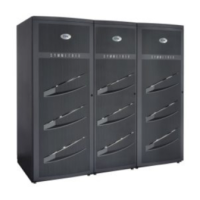206
EMC Symmetrix DMX-3 Product Guide
Data Integrity, Availability, and Protection
Symmetrix DMX RAID 6
This section describes the RAID 6 (6+2) and RAID 6 (14+2) features.
RAID 6 overview
RAID 6 is defined as any configuration that supports more than a
single disk drive failure. Similar to RAID 5 devices, the data blocks
are striped/interleaved across all members of the RAID group.
The following sections describe how RAID 6 functions in Symmetrix
systems:
◆ “RAID 6 attributes” on page 206
◆ “RAID 6 device (volume)” on page 206
◆ “Even-Odd algorithm” on page 207
◆ “RAID 6 (6+2)” on page 208
◆ “RAID 6 (14+2)” on page 208
◆ “Rebuilding data and parity members” on page 209
◆ “RAID 6 configuration guidelines” on page 210
◆ “Comparing RAID 5 and RAID 6” on page 210
RAID 6 attributes
A RAID 6 device has the following attributes:
◆ RAID 6 track size is 64K.
◆ Data blocks are striped/interleaved across all members of the
RAID group.
◆ RAID 6 groups can be:
• Eight members per logical device (6+2)
• Sixteen members per logical device (14+2)
RAID 6 device
(volume)
A RAID 6 device (logical volume) is made of eight or sixteen
hypervolumes each with tracks of data and a parity that rotate.
RAID 6 stripes both data and parity across all hypervolumes of the
RAID 6 device. Logically, the RAID 6 device is represented as a single
mirror device.

